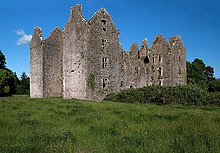
Roscrea is a market town in County Tipperary, Ireland, which in 2016 had a population of 5,446. Roscrea is one of the oldest towns in Ireland, having developed around the 7th century monastery of Saint Crónán of Roscrea, parts of which remain preserved today.

Fethard is a small town in County Tipperary, Ireland. Dating to the Norman invasion of Ireland, the town's walls were first laid-out in the 13th century, with some sections of these defensive fortifications surviving today.

St Mary's Priory Church, Deerhurst, is the Church of England parish church of Deerhurst, Gloucestershire, England. Much of the church is Anglo-Saxon. It was built in the 8th century, when Deerhurst was part of the Anglo-Saxon kingdom of Mercia. It is contemporary with the Carolingian Renaissance on mainland Europe, which may have influenced it.

Ballinalacken Castle is a two-stage tower house located in Killilagh parish of County Clare, Ireland. It is of uncertain date but most likely was built in the 15th or early 16th century.

In Ireland at the end of the sixteenth and beginning of the seventeenth century, the fortified house, along with the stronghouse, developed as a replacement for the tower house. 'Fortified Houses' were often rectangular, or sometimes U or L-shaped, three-storey structures with high gables and chimney stacks and large windows with hood mouldings. Some examples have square towers at the corners. The interiors were relatively spacious with wooden partitions and numerous fireplaces. In a number of cases 'Fortified Houses' were built onto pre-existing tower houses. 'Fortified Houses' were protected by gun fire from the angle towers and bartizans, and were also provided with bawn walls with gunloops, towers and protected gateways. 'Fortified Houses' were built throughout Ireland by large landowners from a variety of backgrounds, such as the Old English Earl of Clanricarde who built Portumna Castle in County Galway; Gaelic lords such as MacDonogh MacCarthy, Lord of Duhallow, who built Kanturk Castle in County Cork; and Cromwellian soldiers such as Sir Charles Coote, who built Rush Hall in County Offaly.
Over the past six decades studies concerning Irish 'Fortified Houses' have identified them as a transitional genre that emerged at the end of the sixteenth century and acted as an architectural bridge between the Irish medieval tower-house and the country manor house of the late seventeenth century. The 'Fortified House' drew on the earlier tradition of the tower-house and was influenced by the Tudor and emerging Jacobean architecture from England and the Classical and Military architecture coming from Continental Europe. The social, political and military changes that took place from the 1580s-1650s were to play a major role in the development of this unique Irish structure. These houses provided a comfortable living space for the elite of early seventeenth-century Irish society. They were fashionable yet defendable. The 'Fortified House' was a public display of power and wealth. They represented a long term investment in their owner’s regional future and were monuments to an aspiration for an English and Continental house style suited to local Irish conditions. On a basic level the construction of a 'Fortified House' represented the owners’ desire to modernise and Anglicize.
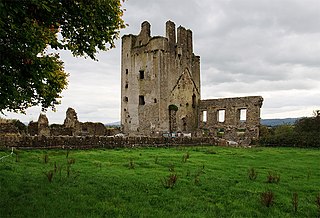
Kilcash Castle is a ruined castle off the N24 road just west of Ballydine in County Tipperary, Ireland. It is in the care of the Irish State. The Butler dynasty has important links to the area.
Richard Butler of Kilcash (1615–1701) was an Irish soldier and landowner, the third son of Thomas Butler, Viscount Thurles and brother of James, 1st Duke of Ormonde. He sided with the Irish Confederacy at the Irish Rebellion of 1641. He scouted the enemy on the morning of the Battle of Cloughleagh. His descendants succeeded to the earldom of Ormond when the senior branch of the family failed in 1758.

Coppingers Court is a ruined four-storey fortified house dating from 1616, situated on private property approximately 1 kilometre (0.6 mi) from the sea. It was built by Sir Walter Coppinger and located in Ballyvireen valley, west of Rosscarbery in County Cork, Ireland. The house has a rectangular centre flanked by two wings on the east and west, resulting in a total of 9 gables.
Sir John Everard was an Irish barrister, politician and judge. He was notable as the last Irish judge until the reign of James II to openly profess the Roman Catholic faith. His religious beliefs eventually led to his enforced resignation from the Bench in 1607.

St James the Great Church is a Grade I listed Church of England parish church dedicated to James, son of Zebedee in Aslackby, Lincolnshire, England. The church is 7 miles (11 km) north from Bourne, and in the Aslackby and Laughton parish on the eastern edge the South Kesteven Lincolnshire Vales.

The Castle of Óbidos is a well-preserved medieval castle located in the civil parish of Santa Maria, São Pedro e Sobral da Lagoa, in the municipality of Óbidos, Portuguese District of Leiria.
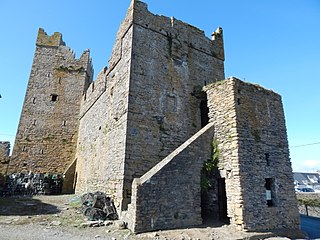
Slade Castle is a tower house and National Monument in County Wexford, Ireland. It is located in the village of Slade on the Hook Peninsula and primarily dates to the late 15th or early 16th century.

Grallagh Castle is a tower house and National Monument located in County Tipperary, Ireland.
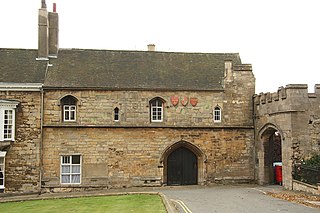
The Vicars’ Court or Vicars’ Choral in Lincoln, is situated in the Minster Yard to the south of Lincoln Cathedral. It was founded as a college of priests by Bishop Sutton in the late 13th century. These priests would take services in the Cathedral in the absence of the Prebendaries. The Vicars‘ Choral of Lincoln is one of eight such colleges in England, and it is also one of the earliest and best preserved. The great majority of the building survives. By 1305 the hall, the kitchen and certain chambers were finished. In 1328 lay brothers were admitted and further houses were built for them During the English Civil War, the buildings were badly damaged and afterwards were converted into four houses.
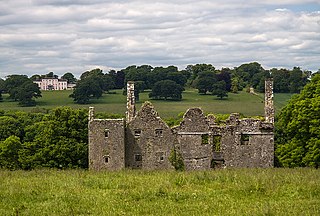
Dromaneen Castle is a fortified house and National Monument located in County Cork, Ireland.

Castlelyons Friary is a former Carmelite Priory and National Monument located in County Cork, Ireland.

The Priory of St. Mary in Cahir, known as Cahir Abbey, was a medieval priory of Augustinian Canons regular and is a National Monument located in Cahir, Ireland.
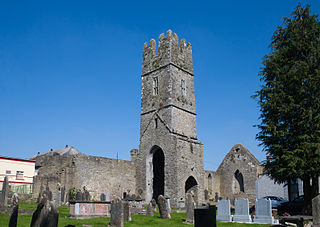
Roscrea Friary is a ruined medieval Franciscan friary and National Monument located in Roscrea, County Tipperary, Ireland. It is on Abbey Street, in the west end of Roscrea, on the north bank of the River Bunnow. The Friary was founded in the 15th century by Greyfriars (Franciscans) and later destroyed by British soldiers. What remains are the north and east walls and the bell-tower.
David Roche, 7th Viscount Fermoy (1573–1635) was an Irish magnate, soldier, and politician.

White's Castle is a 16th-century tower house in Athy, County Kildare, Ireland. Built on the site of an earlier 15th-century castle, White's Castle was built to guard the main river crossing in Athy and was extended over successive centuries.


